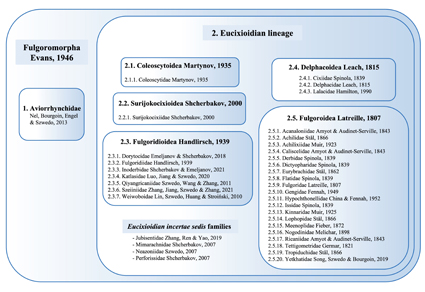Abstract
A synthesis of planthopper suprafamilial and familial classification is provided and discussed, solving some nomenclatural issues for the group, and adopting an enriched presentation with a clear distinction between the taxon name and its concept.
References
- Aristov, D.S. & Rasnitsyn, A.P. (2014) Novye eoblattidy iz permi Rosii i SSHA i proiskhozhdenie ukhovertok (Insecta: Eoblattida, Forficulida). Paleontologicheskiï Zhurnal 2014 (4), 66–71. [in Russian, published in English as: Aristov, D.S. & Rasnitsyn, A.P. (2014) New Eoblattida from the Permian of Russia and the United States and the origin of earwigs (Insecta: Eoblattida, Forficulida). Paleontological Journal, 48, 407–413]
- Becker-Migdisova, E.E. (1961) Superoder Psocopteroidea, Rhynchota. In: Paleozoiskie nasekomye Kuznetskogo basseina. Trudy Paleontologicheskogo Instituta, Akademiya Nauk SSSR 85, 271–393. [in Russian]
- Berendsohn, W.G. (1995) Concept of “potential taxa” in databases. Taxon, 44 (2), 207–212. https://doi.org/10.2307/1222443 DOI: https://doi.org/10.2307/1222443
- Bourgoin, T., Bailly, N., Zaragueta, R. & Vignes-Lebbe, R. (2021) Complete formalization of taxa with their names, contents and descriptions improves taxonomic databases and access to the taxonomic knowledge they support. Systematics and Biodiversity, 19 (7), 738–746. https://doi.org/10.1080/14772000.2021.1915895 DOI: https://doi.org/10.1080/14772000.2021.1915895
- Bourgoin, T. & Szwedo, J. (2022) Toward a new classification of planthoppers Hemiptera Fulgoromorpha: 1. What do Fulgoridiidae really cover? Annales Zoologici, 72 (4), 951–962. https://doi.org/10.3161/00034541ANZ2022.72.4.011 DOI: https://doi.org/10.3161/00034541ANZ2022.72.4.011
- Cohen, K.M., Finney, S.C., Gibbard, P.L. & Fan, J.X. (2013 [updated]) The ICS International Chronostratigraphic Chart, 2023/04. Episodes, 36, 199–204. DOI: https://doi.org/10.18814/epiiugs/2013/v36i3/002
- Evans, J.W. (1946) A natural classification of leaf-hoppers (Jassoidea, Homoptera) Part 1. External morphology and systematic position. Transactions of the Royal Entomological Society of London, 96 (3), 47–60. https://doi.org/10.1111/j.1365-2311.1946.tb00442.x DOI: https://doi.org/10.1111/j.1365-2311.1946.tb00442.x
- Geinitz, F.E. (1880) Der Jura von Dobbertin in Mecklenburg und seine Versteinerungen. Zeitschrift der Deutschen Geologischen Gesellschaft, 32, 510–535.
- Geoffroy, M. & Berendsohn, W.G. (2003) The concept problem in taxonomy: importance, components, approaches. In: Berendsohn, W.G. (Ed.), MoReTax. Handling factual Information linked to taxonomic concepts in biology. Federal Agency for Nature Conservation, Bonn, Germany. Schriftenreihe für Vegetationskunde, 39, pp. 5–14.
- Hamilton, K.G.A. (1992) Lower Cretaceous Homoptera from the Koonwarra fossil bed in Australia, with a new superfamily and synopsis of Mesozoic Homoptera. Annals of the Entomological Society of America, 85 (4), 423–430. DOI: https://doi.org/10.1093/aesa/85.4.423
- Handlirsch, A. (1906–1908) Die fossilen Insekten und die Phylogenie der rezenten Formen. Verlag von Wilhelm Engelmann, Leipzig, ix + 1430 pp., 51 pls. [pp. 1–672 (1906) + 673–1120 (1907) + 1121–1430 (1908), pls. 1–36 (1906) + pls. 37–51 (1907)] https://doi.org/10.5962/bhl.title.34145 DOI: https://doi.org/10.5962/bhl.title.5636
- Handlirsch, A. (1939) Neue Untersuchungen über die fossilen Insekten, Teil 2. Annalen des Naturhistorischen Museums in Wien, 49, 1–240.
- ICZN [International Commission on Zoological Nomenclature] (1961) Opinion 602. Delphax Fabricius, 1798 (Insecta, Hemiptera); Interpretation under the plenary powers. Bulletin of Zoological Nomenclature, 18 (4), 246–248. [https://biostor.org/reference/4557]
- ICZN [International Commission on Zoological Nomenclature] (1999) International Code of Zoological Nomenclature, Fourth Edition: adopted by the International Union of Biological Sciences. The International Trust for Zoological Nomenclature, London, xxix + 306 pp. [https://www.iczn.org/the-code/the-code-online/]
- Latreille, P.A. (1807) Sectio secunda. Familia quarta. Cicadariae. Cicadaires. Genera Crustaceorum et Insectorum secundum ordinem naturalem in familias disposita, iconibus exemplisque plurimis explicata, 3, 1–258. https://doi.org/10.5962/bhl.title.11558 DOI: https://doi.org/10.5962/bhl.title.65741
- Leach, W.E. (1815) Entomology. The Edinburgh Encyclopedia, 9, 57–172. https://doi.org/10.5962/bhl.title.30911 DOI: https://doi.org/10.5962/bhl.title.30911
- Linnaeus, C. (1758) Systema naturae per regna tria naturae, secundum classes, ordines, genera, species, cum characteribus, differentiis, synonymis, locis. Tomus I. Editio decima, reformata. Laurentii Salvii, Holmiæ, [4] + 824 pp. https://doi.org/10.5962/bhl.title.542 DOI: https://doi.org/10.5962/bhl.title.542
- Linné, C. (1767) Systema Naturae. Editio duodecima, reformata, 1, 533–1327.
- Luo, Y., Bourgoin, T., Szwedo, T. & Feng, J.N. (2021) Acrotiarini trib. nov. in Cixiidae (Insecta, Hemiptera, Fulgoromorpha): three new genera from the mid-Cretaceous amber of northern Myanmar and new insights in the classification of the family. Cretaceous Research, 128 (104959), 1–17. https://doi.org/10.1016/j.cretres.2021.104959 DOI: https://doi.org/10.1016/j.cretres.2021.104959
- Martynov, A.V. (1935) Permian fossil insects from the Arkhangelsk district. Part 5. Homoptera. Trudy Paleontologicheskogo Instituta, Akademiya Nauk SSSR 4, 1–35.
- Nel, A., Roques, P., Nel, P., Prokin, A.A., Bourgoin, T., Prokop, J., Szwedo, J., Azar, D., Desutter-Grandcolas, L., Wappler, T., Garrouste, R., Coty, D., Huang, D.Y., Engel, M.S. & Kirejtshuk, A.G. (2013) The earliest known holometabolous insects. Nature, 503 (7475), 257–261. https://doi.org/10.1038/nature12629 DOI: https://doi.org/10.1038/nature12629
- Panzer, G.W. (1796) Cicada crassicornis, Cicada dubia. Faunae insectorum Germanicae initia: oder Deutschlands Insecten Hemiptera, 35, 19–20. https://doi.org/10.5962/bhl.title.12432 DOI: https://doi.org/10.5962/bhl.title.15007
- Shcherbakov, D.E. (1988) Origin and evolution of Auchenorrhyncha based on fossil evidence. Proceedings of the XVIIIth International Congress of Entomology, Vancouver, BC, Canada, 3–9 July 1988, 8.
- Shcherbakov, D.E. (1996) Origin and evolution of the Auchenorrhyncha as shown by the fossil record. In: Schaefer, C. W. (Ed.), Studies on hemipteran phylogeny. Entomological Society of America, Lanham, pp. 31–45.
- Shcherbakov, D.E. (2000) Permian faunas of Homoptera (Hemiptera) in relation to phytogeography and the Permo-Triassic crisis. Paleontological Journal, 34, S251–S267.
- Sorensen, J.T., Campbell, B.C., Gill, R.J. & Steffen-Campbell, J.D. (1995) Non-monophyly of Auchenorrhyncha (‘‘Homoptera’’), based upon 18S rDNA phylogeny: eco-evolutionary and cladistic implications within pre-Heteropterodea Hemiptera (s.l.) and a proposal for new monophyletic sub-orders. Pan-Pacific Entomologist, 71 (1), 31–60.
- Spinola, M. (1839) Essai sur les Fulgorelles, sous-tribu de la tribu des Cicadaires, ordre des Rhyngotes. Annales de la Société Entomologique de France 8, 133–337 + 339–454, pls. 1–7.
- Szwedo, J. (2018) The unity, diversity and conformity of bugs (Hemiptera) through time. Earth and Environmental Science Transactions of the Royal Society of Edinburgh, 107 (2–3), 109–128. [2017] https://doi.org/10.1017/S175569101700038X DOI: https://doi.org/10.1017/S175569101700038X
- Szwedo, J., Bourgoin, T. & Lefebvre, F. (2004) Fossil planthoppers (Hemiptera: Fulgoromorpha) of the World. An annotated catalogue with notes on Hemiptera classification. Studio 1, Warszawa, 199 pp., 8 pls.
- Zhao, Z.Q., Bourgoin, T., Szwedo, J., Song, Z.S., Chen, L. & Luo, C.H. (2023) The oldest genus and species of the fulgoroidian lineage in hemipteran Fulgoroidea from the Lower Cretaceous Laiyang Formation of China. Cretaceous Research, 143 (105423), 1–8. https://doi.org/10.1016/j.cretres.2022.105423 DOI: https://doi.org/10.1016/j.cretres.2022.105423


